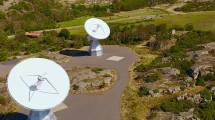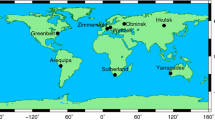Summary
Many GPS networks which were initially surveyed with Texas Instruments TI-4100 receivers have now been resurveyed with mixtures of TI-4100 and Trimble 4000 receivers or exclusively with Trimble receivers. In order to make confident tectonic interpretation of displacements observed between such surveys, it is necessary to understand any biases which may be introduced by using different receiver types or by mixing receivers within a network. Therefore, one of the primary objectives of the Ecuador 1990 GPS campaign (February 1990) was to provide a direct long baseline comparison between the TI-4100 and Trimble 4000SDT GPS receivers. p ]During this campaign, TI and Trimble receivers were co-located at each end of a 1323 kilometer baseline (Jerusalen to Baltra). Solutions for this baseline show no variation with receiver type. Zero-length baseline solutions showed no evidence for any intrinsic bias caused by mixing the two receiver types. Short baseline solutions indicate a bias of -34±10 mm in the baseline vertical component; the sign of the bias indicates that either the assumed phase center location for the TI is too low or the assumed location for the Trimble is too high. The bias is explainable if the phase centers of the Trimble SDT and SST antennas are similarly located. p ]Solutions for baselines measured with codeless receivers (such as the Trimble) should be as precise as those for baselines measured with P-code receivers (such as the TI) as long as it is possible to resolve ambiguities. Resolution of the widelane ambiguity is the limiting factor in ambiguity resolution with any codeless receiver, and in the February 1990 campaigns it was not successful fore baselines longer than 100 km. Without explicit modeling of the ionospheric effect on the widelane, ambiguity resolution with codeless receivers will not be successful for baselines longer than about 100 km, depending on the local ionospheric conditions.
Similar content being viewed by others
References
Blewitt G (1989) Carrier Phase Ambiguity Resolution for the Global Positioning System Applied to Geodetic Baselines up to 2000 km. J. Geophys. Res. 94: 10,187–10,203.
Blewitt G (1990) An Automatic Editing Algorithm for GPS Data. Geophys. Res. Letts. 17: 199–202.
Chin M (1990) CIGNET Report. GPS Bulletin 2: 21–36.
Dong D-N, Bock Y (1989) Global Positioning System network analysis with phase ambiguity resolution applied to crustal deformation studies in California. J. Geophys. Res. 94: 3949–3966.
Feigl, KL (1991) Geodetic measurement of tectonic deformation in Central California., Ph.D. Thesis, Massachusetts Institute of Technology, Cambridge, 222 pp.
Freymueller IT, Kellogg JN (1990) The Extended Tracking Network and Indications of Baseline Precision and Accuracy in the North Andes. Geophys. Res. Letts. 17:207–210.
Freymueller IT (1992) PhasEdit: An automatic data editing program for dual-frequency codeless GPS receivers (software and documentation). unpublished.
Gurtner W, Beutler G, Rothacher M (1989) Combination ofGPS observations made with different receiver types. In: Proc. Fifth lnl. Geod. Symp. on Satellite Positioning, March 13–17, Las Cruces, NM, 362–374.
Henson OJ, Collier EA, Schneider KR (1985) Geodetic applications of the Texas Instruments TI-4100 GPS Navigator. In: Proceedings of the First International Symposium on Precise Positioning with GPS, Rockville, MD: 191–200.
Joselyn J A., Tsurutani BT ( 1990) Geomagnetic impulses and Storm Sudden Commencements. EOS Trans. Am. Geophys. Un. 71: 1808–1809.
Kellogg J N, Freymueller IT, Dixon TH, Neilan RE, Ropain C, Camargo S, Fernandez B, Stowell JL, Salazar A, Mora J, Espin L, Perdue V, Leos L (1990) First GPS Baseline Results from the North Andes. Geophys. Res. Letts. 17: 211–214.
Lichten SM, Border JS (1987) Strategies for High Precision GPS Orbit Determination. J. Geophys. Res. 92: 12,751–12,762.
Prescott W, Davis J, Svarc J (1989) Height of L2 phase center for TI antennas. GPS Bulletin 2: 13.
Rocken C, Meertens C (1989) GPS antenna and receiver tests: Multipath reduction and mixed receiver baselines. In: Proc. Fifth lnt. Geod. Symp. on Satellite Positioning, March 13–17, Las Cruces, NM, 375–385.
Schupler BR, Oark TA (1991) How different antennas affect the GPS observable. GPS World, 2 no. 10: 32–36.
Sims ML (1985) Phase center variation in the geodetic TI-41 00 GPS receiver system’s conical spiral antenna. In: Proceedings of the First International Symposium on Precise Positioning with GPS, Rockville, MD: 227–244.
Sovers OJ, Border JS (1990) Observation Model and Parameter Partials for the JPL Geodetic GPS Modeling Software “GPSOMC”. JPL Publication 87-21, Rev. 2, Jet Propulsion Laboratory.
Wild U, Beutler G, Fankhauser S, Gurtner W (1990) Stochastic properties of the ionosphere estimated from GPS observations. In: Proceedings of the 2nd International Symposium on Precise Positioning with the Global Positioning System, Ottawa, Canada, September 3–7, 1990: 411–428.
Author information
Authors and Affiliations
Rights and permissions
About this article
Cite this article
Freymueller, J.T. Comparison of baseline results for the TI-4100 and Trimble 4000SDT geodetic GPS receivers. Bulletin Geodesique 66, 272–280 (1992). https://doi.org/10.1007/BF02033187
Received:
Accepted:
Published:
Issue Date:
DOI: https://doi.org/10.1007/BF02033187




